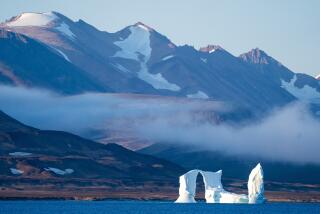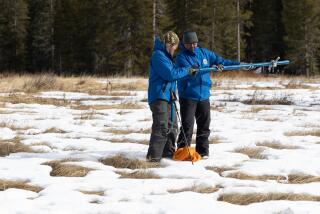A climate warning for another species
- Share via
The king penguin, a species that rebounded from near-extinction over the last century, could be wiped out in coming decades due to global warming, researchers reported Monday.
If the surface temperature of the Southern Ocean rises 0.47 degrees Fahrenheit -- an increase well below current forecasts of 0.72 degrees over the next 20 years -- declining food availability would lead to a population collapse, the scientists estimated.
“We don’t have to get several degrees of increase to get a big effect,” said Yvon Le Maho, a physiologist at the French National Center for Scientific Research and lead author of the study, which was published in the Proceedings of the National Academy of Sciences.
The research followed 456 adult birds with radio transponders implanted under their skin and correlated their survival rate over an eight-year period with changes in sea surface temperatures.
Christophe Barbraud, a scientist at the same center but not involved in the study, said the time period was probably too short to draw a definitive link between temperature and survival.
Still, the study supports other research, including Barbraud’s own work on a dramatic decline of emperor penguins in Antarctica, that climate change can harm sea bird populations, he said.
King penguins, which can live up to 30 years, were hunted nearly to extinction in the 19th century by sailors who used their fat as stove oil. They have since bounced back, and they number about 2 million today.
The bulk of the population lives in colonies on the Crozet Archipelago, French islands more than 1,000 miles north of Antarctica.
During the breeding season from November to March, a pair of adults cares for one chick, feeding it lantern fish from nearby waters.
The lantern fish colonies later migrate deeper in the ocean, leaving the chicks to survive on their fat stores, while the adults travel hundreds of miles south to the edge of the Antarctic ice sheet to feed on krill. The adults return in October to finish raising their young.
By using the radio transponders, the researchers tracked how many adults returned. When a pair of penguins returned, the researchers used binoculars to see if the chick was alive.
Through the natural variations in water temperature over the course of the study’s observation period, the research found that in warm years, chicks were less likely to survive the winter’s fast, most likely because there was not enough local fish for their parents to fatten them, the researchers said. Chick mortality rose by as much as 50%.
Because warm years reduce the availability of krill near the sea ice, fewer adults survive to return to the colony to finish rearing their young.
“A slight increase in temperature has a huge effect on krill production,” Le Maho said.
The warmest year they recorded, 1997, led to a 14% adult mortality rate. The coolest year, 2000, resulted in a 5% death rate.
The increase in mortality was well past the point of maintaining a stable population, even though the difference in sea surface temperature between those two years was relatively small: 0.47 degrees.
“Their entire life histories evolved around ice and the freezing point,” said penguin expert William Fraser, director of the nonprofit Polar Ocean Research Group in Sheridan, Mont., who was not part of the study. “Any change in temperature that turns ice to water has huge impacts.”
Gerald Kooyman, a marine biologist at the Scripps Institution of Oceanography in La Jolla, who was not involved in the research, said the king penguin population is healthy for now.
But “if a population this robust starts to decline, that’s an indicator,” he said. “Our worries will go way beyond king penguins.”







